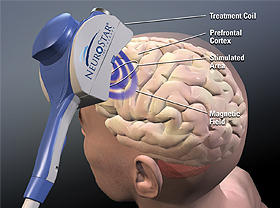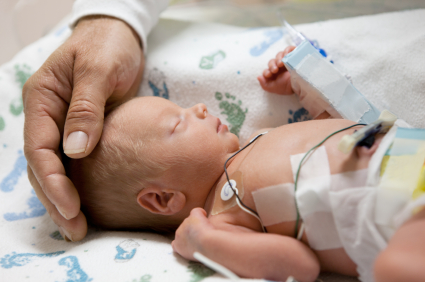Lithium Increases the Volume of the Prefrontal Cortex in Responders
 Studies have indicated that lithium increases gray matter and the volume of the cortex and hippocampus in patients with bipolar I disorder. A poster presented by S. Selek et al. at the 5th Biennial Conference of the International Society for Bipolar Disorders described a longitudinal study of fronto-limbic brain structures in patients with bipolar I disorder during lithium treatment.
Studies have indicated that lithium increases gray matter and the volume of the cortex and hippocampus in patients with bipolar I disorder. A poster presented by S. Selek et al. at the 5th Biennial Conference of the International Society for Bipolar Disorders described a longitudinal study of fronto-limbic brain structures in patients with bipolar I disorder during lithium treatment.
This study reported that patients whose illness failed to respond to lithium had smaller right amygdalas than euthymic bipolar I patients or healthy controls. After treatment with lithium, those who responded well to the drug showed significant enlargement of the left prefrontal cortex and the left dorsolateral prefrontal cortex, while those who responded poorly to lithium showed decreases in the volume of their left hippocampus and right anterior cingulate cortex.
Editor’s Note: This is one of several studies that suggest a relationship between volume of brain regions and degree of response to lithium. These data add to the remarkably consistent literature suggesting that lithium may have neurotrophic and neuro-protective effects, potentially because of the drug’s ability to increase neuroprotective factors such as BDNF and Bcl-2 while decreasing cell death factors such as BAX and p53.
Lithium Reduces Suicide Rate and Increases Longevity
 Suicide is an unfortunate consequence of bipolar disorder in 10-15% of patients. A study by Manchia et al. examined suicidal behavior in 737 families of bipolar patients, including 4,919 first-degree relatives. Suicidal behavior ran in families and was more prevalent in those with an early age of onset and a shorter duration of illness. The good news: lithium treatment decreased suicide risk independent of its degree of effectiveness in treating bipolar disorder. Those on lithium also had a longer median age of survival (73 versus 65 years).
Suicide is an unfortunate consequence of bipolar disorder in 10-15% of patients. A study by Manchia et al. examined suicidal behavior in 737 families of bipolar patients, including 4,919 first-degree relatives. Suicidal behavior ran in families and was more prevalent in those with an early age of onset and a shorter duration of illness. The good news: lithium treatment decreased suicide risk independent of its degree of effectiveness in treating bipolar disorder. Those on lithium also had a longer median age of survival (73 versus 65 years).
Editor’s Note: These data are consistent with a variety of other studies and raise the question why lithium is used less frequently in the US than in many European countries and Canada. Given its neuroprotective effects, its prevention of suicide and dementia, and its positive effects on longevity, it is hard to see why lithium is not included in the treatment regimens of more patients (at whatever dosage is well-tolerated), even if it alone is not sufficient for treating their manic and depressive episodes.
Research (by this editor Robert Post and colleagues) shows that bipolar disorder is a more pernicious illness in almost all respects in the US compared to the Netherlands and Germany (International Journal of Neuropsychopharmacology, 2011). Whether bipolar illness would be less severe in the US if it were more often treated with lithium is an unanswered question. The field cannot provide an answer with systematic prospective controlled data, as most study designs would be unethical (i.e. would deny useful treatment to suffering patients), although one large randomized comparative study called BALANCE did show the superiority of lithium over valproate. However, individual patients in consultation with their physician could evaluate the evidence and request that lithium be considered in their treatment regimen.
If a patient has some clinical predictors of a likely good response to lithium, the decision to include lithium should be a slam-dunk. Some of these include: a positive family history of mood disorder, especially bipolar disorder; a classic course with distinct episodes and clear periods of wellness; manic episodes that are euphoric as opposed to dysphoric (i.e. anxious/irritable); lack of an anxiety disorder or substance abuse comorbidity; the absence of mood-incongruent delusions; and a sequence of episodes of mania followed by a depression and then a well interval (MDI) rather than the sequence of DMI.
Ginkgo Biloba Improves Tardive Dyskinesia
 Tardive dyskinesia is a sometimes irreversible side effect of antipsychotic treatment, and is characterized by uncontrollable, subtle and spontaneous motor movements, usually of the tongue, mouth, or fingers.
Tardive dyskinesia is a sometimes irreversible side effect of antipsychotic treatment, and is characterized by uncontrollable, subtle and spontaneous motor movements, usually of the tongue, mouth, or fingers.
Extracts of the leaves of the gingko biloba tree contain potent antioxidants. In a study published by Zhang et al. in the journal Biological Psychiatry in 2012, treatment with ginkgo biloba (EGb-761) at 240mg/day for 12 weeks improved tardive dyskinesia more than placebo. Patients with tardive dyskinesia had low levels of brain-derived neurotrophic factor (BDNF) at baseline, and gingko biloba increased these levels. BDNF is important for the production and protection of neurons, and maintaining long-term memory.
The increase in BDNF was correlated with the degree of improvement achieved with gingko biloba in these patients. Different people have different variations in the gene for BDNF. As a result, some people’s BDNF is transported to dendrites and synapses more efficiently than others’. Improvement was greatest in those patients with the most common and best-functioning variant of BDNF, Val66Val, and worst in those patients with the rare and poorest-functioning variant, Met66Met.
Editor’s Note: These findings could be of great clinical importance. Tardive dyskinesia occurred in 20 to 40% of patients with bipolar disorder following treatment with the older “typical” antipsychotics. The incidence is much lower with the newer “atypical” antipsychotics, but having an effective and well-tolerated treatment for this disfiguring side effect is an extra bonus.
RTMS Improves Working Memory In Patients With Schizophrenia
 Repetitive transcranial magnetic stimulation (rTMS) may improve working memory in patients with schizophrenia, according to a small study published by Zafiris J. Daskalakis and colleagues in Biological Psychiatry in 2013. Patients with schizophrenia received either 20 Hz rTMS over the left and right prefrontal cortex or a sham treatment, and the rTMS improved working memory on a particular task, the n-back task, wherein patients are asked to recall whether a stimulus they’re currently viewing is the same as the previous one they viewed, or one they viewed several times back. Twenty sessions of rTMS over a period of 4 weeks brought memory back to the levels seen in normal controls.
Repetitive transcranial magnetic stimulation (rTMS) may improve working memory in patients with schizophrenia, according to a small study published by Zafiris J. Daskalakis and colleagues in Biological Psychiatry in 2013. Patients with schizophrenia received either 20 Hz rTMS over the left and right prefrontal cortex or a sham treatment, and the rTMS improved working memory on a particular task, the n-back task, wherein patients are asked to recall whether a stimulus they’re currently viewing is the same as the previous one they viewed, or one they viewed several times back. Twenty sessions of rTMS over a period of 4 weeks brought memory back to the levels seen in normal controls.
Editor’s Note: Since many patients with bipolar disorder also have deficits in prefrontal-based memory and performance even when euthymic, it will be important to see if rTMS would also be helpful in these patients. RTMS at 20 Hz increases neuronal activity as measured by PET scan of the prefrontal cortex and other regions of the brain, and this lasts for at least 48 hours after each treatment.
Since many patients with schizophrenia and bipolar disorder show deficits in prefrontal activity at baseline, the normalization of these alterations could relate to the memory improvement. This proposition could be tested relatively easily.
Intranasal Ketamine Helps Some Kids with Bipolar Disorder
 The anesthetic ketamine given intranasally may help children with a certain type of bipolar disorder. In an article published in the Journal of Affective Disorders in 2013, Demetri Papolos et al. reported seeing marked improvement in a subgroup of 12 children aged 6 to 19 years of age who were nonresponsive to the usual treatment regimens of lithium, mood stabilizers, and antipsychotics. Papolos has described these children as having the “fear of harm (FOH) subtype.” In addition to having typical mood swings, these children also have a fear of aggression, separation anxiety, sleep and circadian rhythm disorders, nightmares, thermoregulatory problems, and carbohydrate craving.
The anesthetic ketamine given intranasally may help children with a certain type of bipolar disorder. In an article published in the Journal of Affective Disorders in 2013, Demetri Papolos et al. reported seeing marked improvement in a subgroup of 12 children aged 6 to 19 years of age who were nonresponsive to the usual treatment regimens of lithium, mood stabilizers, and antipsychotics. Papolos has described these children as having the “fear of harm (FOH) subtype.” In addition to having typical mood swings, these children also have a fear of aggression, separation anxiety, sleep and circadian rhythm disorders, nightmares, thermoregulatory problems, and carbohydrate craving.
Ketamine was given as an intranasal spray using an inhaler in 10mg doses. Doses were increased until the targeted symptoms remitted. Average doses ranged from 30mg to 120mg, given every 3 to 7 days. All symptom areas including depression and mania improved markedly, usually within a few hours, and this improvement lasted 3 to 4 days. Four types of aggression (measured on the Overt Aggression Scale) decreased significantly.
There were some dissociative side effects that were usually mild to moderate, but occasionally severe. They resolved spontaneously, usually within the first hour after treatment, and there appeared to be tolerance to them following repeated administration.
The authors urged caution until findings from these cases are confirmed by more controlled studies, but they concluded that the magnitude and rapidity of effects in these children with treatment resistant bipolar disorder suggested effectiveness and safety.
Women with Bipolar Disorder at Higher Risk for Postpartum Depression
 The risk of having a depressive episode during pregnancy compared to afterward have not often been studied. A 2011 review article by Viguera et al. in the American Journal of Psychiatry compared rates of affective episodes among women with bipolar I and II disorders and recurrent major depressive disorder, both during pregnancy and the postpartum period. Risks were higher for women with bipolar disorder.
The risk of having a depressive episode during pregnancy compared to afterward have not often been studied. A 2011 review article by Viguera et al. in the American Journal of Psychiatry compared rates of affective episodes among women with bipolar I and II disorders and recurrent major depressive disorder, both during pregnancy and the postpartum period. Risks were higher for women with bipolar disorder.
Among women with bipolar disorder, 23% experienced mood episodes during the pregnancy, while 52% had an episode in the months after giving birth. Among women with unipolar depression, 4.6% had a mood episode during pregnancy, while 30% did during the postpartum period, which is about double the risk seen in the general population. Depression was the most common type of morbidity the women experienced before and after giving birth.
Risk factors associated with mood episodes during pregnancy included (in descending order): younger age at illness onset, previous postpartum episodes, fewer years of illness, bipolar disorder, fewer children, and not being married. Risk factors associated with postpartum episodes included: younger age at illness onset, illness during pregnancy, bipolar disorder, fewer children, and more education.
Editor’s Note: The risk of postpartum depression increases from 15% in the general population, to 30% among women with unipolar disorder, to 50% in women with bipolar disorder. Special precautions should be taken to monitor and treat depression during and after pregnancy, in all women but particularly in those with a prior history of unipolar or bipolar disorder.
Preterm Birth Is a Risk Factor for Bipolar Disorder
A study published in the Archives of General Psychiatry in 2012 sampled over one million births in Sweden and suggested that preterm birth (from 32 to 36 weeks) doubled the risk that a child would develop bipolar disorder later in life. Those born even earlier had a sevenfold increased risk for bipolar disorder.
Editor’s Note: A robust research literature indicates that schizophrenia is related to obstetrical and other pre- and perinatal medical problems. Now it seems bipolar disorder may be as well, with some caveats. Low Apgar score (which indicates difficulties at birth) and delayed growth were not found to relate to bipolar risk. Thus something about the shortened preterm development seems to convey the risk. The authors suggest that there may be different types of factors that predispose a person to develop bipolar disorder, and that in some people the illness may have development origins.
These data also fit with observations that only about 50% of patients with bipolar disorder have a positive family history of the illness. Thus, while bipolar disorder does run in families and has a strong genetic basis in many instances, there are many people who develop the illness without having this genetic/familial risk. Very preterm birth appears to be one other contributing risk factor, presumably among many others. Understanding the neurobiological mechanisms occurring before birth that mediate this risk may lead to direct preventive measures to lessen the risk. In the meantime, traditional measures supporting good maternal and fetal health are a good place to start. These include regular prenatal checkups, good nutrition, and prenatal vitamins that include high doses of folic acid.
Study of Twins Sheds Light on Epigenetic Mechanisms Implicated In Bipolar Disorder
At the 5th Biennial Conference of the International Society for Bipolar Disorders, H. Sugawara and colleagues reported on a particular example of epigenetics, an emerging field that studies ways that events and substances in the environment affect the structure of DNA. Often methyl or acetyl groups attach to DNA, making it easier or more difficult to transcribe. Sugawara’s group discussed hypermethylation of the serotonin transporter gene in bipolar disorder in an analysis of monozygotic twins discordant for bipolar disorder.
Monozygotic (identical) twins are highly concordant for bipolar disorder, meaning if one has the illness the other is likely to, but this does not occur 100% of the time. Thus, environmental or epigenetic mechanisms could account for the lack of genetic transmission of the illness in the odd cases in which one twin does not develop the illness.
Sugawara’s research group found that DNA hypermethylation of the allele encoding the serotonin transporter occurred in the twins with bipolar illness but not in those without. Once the expression of this particular gene had been identified as a difference between twins with and without bipolar disorder, the researchers examined the gene in non-twin patients with bipolar disorder compared to healthy controls and confirmed that people with bipolar disorder were more likely to have the hypermethylated allele.
The researchers believed that carrying a short form of the serotonin transporter was associated with DNA hypermethylation, and they went on to study the expression of mRNA for the transporter in bipolar patients carrying the short form of the allele. They found that DNA methylation was also higher at the serotonin transporter site in postmortem brains of bipolar patients.
Editor’s Note: This study provides one of the first insights into possible environmental mechanisms that explain why some people at risk for bipolar disorder develop the illness and others do not. Another possible mechanism for differential expression of the illness has been suggested by E.F. Torrey and colleagues, who believe that a viral infection may enter an individual’s genome and directly alter DNA sequences. The current data from Sugawara’s research group suggest the importance of further study of the serotonin transporter site in bipolar disorder and the mechanistic reasons for the DNA hypermethylation that occurs there.
Antiepileptic Drugs for Bipolar Disorder Do Not Increase Risk of Suicidal Behavior
![]() A 30-year observational study published by Andrew Leon and colleagues in the American Journal of Psychiatry has found that anticonvulsants used in epilepsy and for bipolar depression (carbamazepine, lamotrigine, and valproate) do not increase suicidal behavior in bipolar patients.
A 30-year observational study published by Andrew Leon and colleagues in the American Journal of Psychiatry has found that anticonvulsants used in epilepsy and for bipolar depression (carbamazepine, lamotrigine, and valproate) do not increase suicidal behavior in bipolar patients.
Editor’s Note: The FDA gave a warning in 2009 that these anticonvulsants were associated with suicidal ideation. This was based on studies of a mixed group of psychiatry and neurological patients in acute placebo-controlled studies, where suicidal ideation is typically a reason for exclusion from the study. Leon et al. used more powerful longitudinal methods to compare the risk of suicidal ideation in individuals taking and not taking anticonvulsants and found no such increase in suicidal behavior.
This is like the FDA warning for antidepressants and suicide, which was based on data from placebo-controlled clinical trials in acute depression (where suicidal patients are excluded). When investigators used the same longitudinal methods as Leon et al. in the anticonvulsant study, they found that antidepressants actually reduced suicidal behavior by 30%.
The bottom line is that the use of anticonvulsants for bipolar disorder should not be discouraged based on the FDA warning about suicidal ideation in mixed neurological and psychiatric patients. In bipolar patients, anticonvulsants do not increase the risk of suicidal behaviors, i.e. suicidal acts or completed suicides.
High Rate of Mood Stabilization on Adjunctive Lamotrigine in Adolescents with Bipolar Disorder
 At the 2012 meeting of the American Academy of Child and Adolescent Psychiatry (AACAP), Melissa P. DelBello presented a poster on the design of a maintenance study in bipolar youth to determine characteristics of patients who stabilized on adjunctive lamotrigine. The study included children aged 10 to 17 who had been diagnosed with bipolar disorder. Of a total 244 potential subjects, 160 individuals or 66% stabilized on lamotrigine during the open (not blind) portion of the study. Of these, 143 were randomized to either lamotrigine continuation or placebo.
At the 2012 meeting of the American Academy of Child and Adolescent Psychiatry (AACAP), Melissa P. DelBello presented a poster on the design of a maintenance study in bipolar youth to determine characteristics of patients who stabilized on adjunctive lamotrigine. The study included children aged 10 to 17 who had been diagnosed with bipolar disorder. Of a total 244 potential subjects, 160 individuals or 66% stabilized on lamotrigine during the open (not blind) portion of the study. Of these, 143 were randomized to either lamotrigine continuation or placebo.
Seventeen participants did not enter the randomized phase of the study, primarily because of withdrawal of consent, presumably because they were reluctant to be placed in the placebo group. The authors concluded that a study design involving randomization to medication continuation versus withdrawal with placebo substitution could underestimate the true level of treatment response.
However, the high stabilization rate of 66% using adjunctive lamotrigine in the open phase of the study suggests that the drug is effective. Clearly confirmation of this in the double-blind randomized phase is needed to confirm this prediction.



